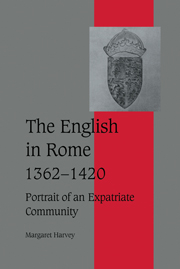Book contents
- Frontmatter
- Contents
- Acknowledgements
- List of abbreviations
- Maps
- Introduction
- 1 The setting I: Rome in the later fourteenth century, 1362–1376
- 2 The setting II: Rome, 1376–1420
- 3 S Thomas's hospice
- 4 S Chrysogonus' hospice and other enterprises
- 5 The laity in Rome
- 6 Women
- 7 The English in the curia 1378–1420: I
- 8 The English in the curia 1378–1420: II
- 9 The career of John Fraunceys
- 10 Adam Easton, an English cardinal: his career
- 11 Adam Easton's ideas and their sources
- 12 Conclusion
- Bibliography
- Index
- Cambridge Studies in Medieval Life and Thought Fourth Series
11 - Adam Easton's ideas and their sources
Published online by Cambridge University Press: 28 July 2009
- Frontmatter
- Contents
- Acknowledgements
- List of abbreviations
- Maps
- Introduction
- 1 The setting I: Rome in the later fourteenth century, 1362–1376
- 2 The setting II: Rome, 1376–1420
- 3 S Thomas's hospice
- 4 S Chrysogonus' hospice and other enterprises
- 5 The laity in Rome
- 6 Women
- 7 The English in the curia 1378–1420: I
- 8 The English in the curia 1378–1420: II
- 9 The career of John Fraunceys
- 10 Adam Easton, an English cardinal: his career
- 11 Adam Easton's ideas and their sources
- 12 Conclusion
- Bibliography
- Index
- Cambridge Studies in Medieval Life and Thought Fourth Series
Summary
Adam Easton's reputation both in England and the curia depended on his theology. As a leading pro-papalist at the outbreak of the schism his ideas and their sources were important. The breadth of his reading, compared for instance with that of his contemporary from Oxford days, Nicholas Radcliffe, on some of the same subjects, is impressive, reflecting in part the greater availability of libraries in Rome and Avignon and a wider experience.
His greatest work, Defensorium ecclesiastice potestatis (which for clarity I shall refer to as De ecclesiastica potestate), probably originated in debates in Oxford about the origins of dominion, followed by further exploration of the question in Avignon, finally quickened by the advent of Wyclif. Easton supplied expertise for the bull against Wyclif and this colours the last section of the book.
The extremely long and very discursive work traces the development of dominion from its origins in the heavenly hierarchy, through its arrival on this earth, with a discussion of Adam before and after the Fall, then a history of human beings and their politics until the coming of Christ and finally dominion in the Christian era. The whole defends a very high doctrine of papal power; throughout priests had dominion over everyone else. Easton took his model from pseudo-Dionysius, thought by all fourteenth-century scholars to be Dionysius the Areopagite, converted by S Paul, ‘the greatest doctor of the church after the apostles’ as Easton put it.
- Type
- Chapter
- Information
- The English in Rome, 1362–1420Portrait of an Expatriate Community, pp. 213 - 237Publisher: Cambridge University PressPrint publication year: 2000



